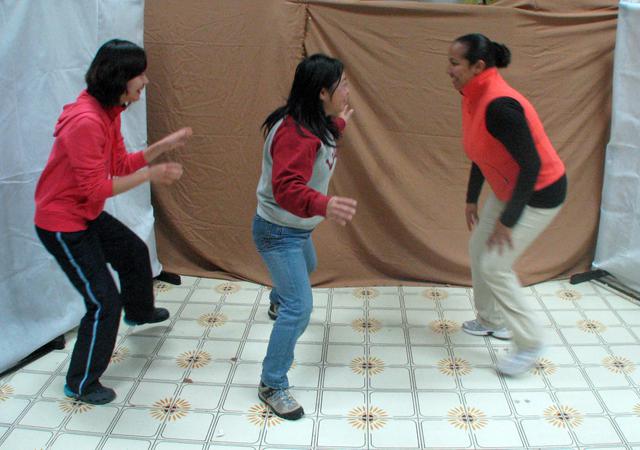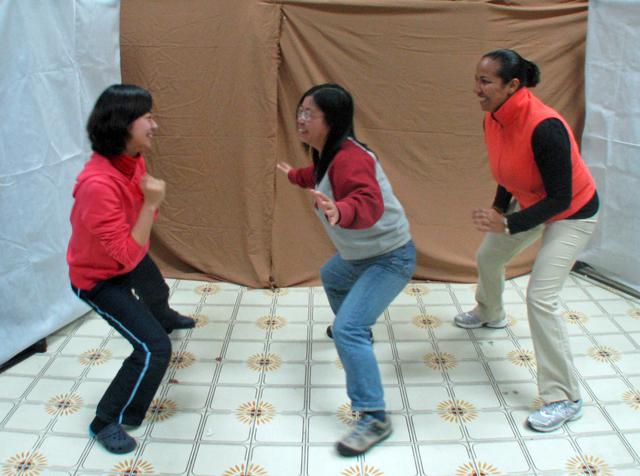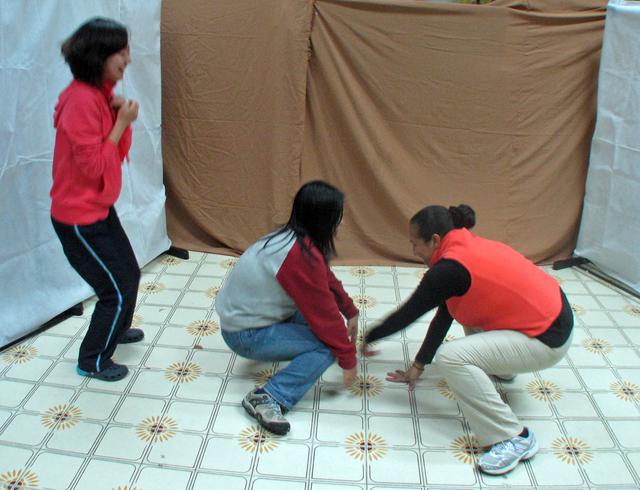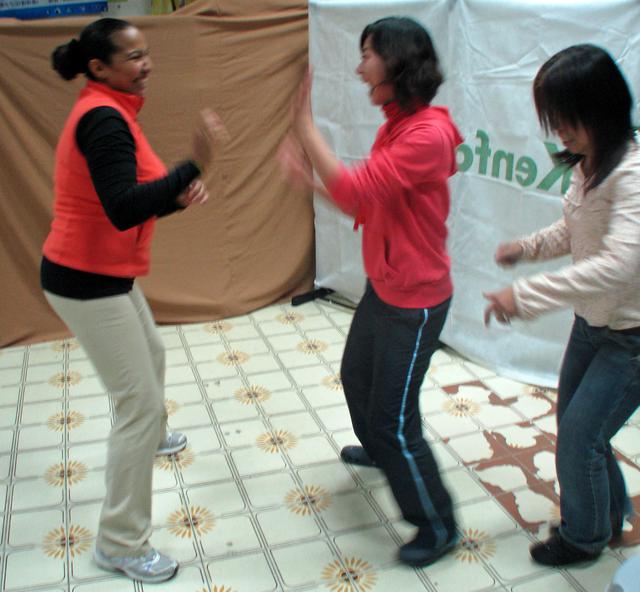_____________________________________________________________________________________________
THE CARTOON RUN
You will need a space large enough to run from one point to another, so it may have to be outside. It’s a good exercise to let off steam; a good workout. Exhausting yet exhilarating, using most all the muscles.
Imagine the Road Runner just as he gets ready to dash off. Time is suspended while his legs twirl like a locomotive. Then his legs run off and his body eventually follows as if thrust by an elastic cord. This is what we have to imagine when the participants dash off.
Line up on one side of the room/garden. First run in place leaning slightly backwards, with the knees up as high as possible (kick the ceiling with your knees.) Higher, faster, higher, faster!
At the signal "Go!" (whistle) push the body forward and run. Once everyone is on the other side, run in place until the second signal to go.
______________________________________________________________________________________________
THE BOSS AND THE SECRETARY
Two hats, two jackets, a letter, a notepad and pencil
Actor A is the Boss, Actor B is the Secretary. B hands A a letter, A opens it, reads, and starts pacing. S/he has just been informed s/he lost everything in the stock market. I'm ruined! I lost everything! My house! My car! I'm an idiot!
B is close behind with the same steps, writing on the pad, and repeats what A says after every sentence; - I'm ruined! - Yes, you're ruined. - I lost everything! -You lost everything. ....Yes, you're an idiot.
When you say "Change" they exchange hats, jackets, notepad, pencil and letter. They have ten seconds, if they haven't finished they must dress while they're pacing. (The audience can do the countdown with you.) B, now the Boss, reads the letter and starts pacing with the Secretary close behind."I've lost everything..."
__________________________________________________________________________________________
THE BUS STOP
Eight chairs are placed in two lines, like the inside of a bus, and one extra chair for the driver. Players walk on after putting money in a machine, and sit. Each player is occupied, looks out the window, looks for something in a bag, pulls open a book.
When the driver starts the bus the players must move as if the motor were running, lean back when the bus starts to move forward, and lean forward when the bus stops. This means they must concentrate on what they are doing while concentrating on the movements of the driver.
__________________________________________________________________________________________
THE WALL
Divide the class into groups of five (more or less) and have each group line up facing front, arms down. They must stand as close together as possible, as if it were a wall as it goes sideways, first one way, then the opposite.
Form two or three larger groups (seven - ten to a wall) and have the students practice walking sideways. Then walk sideways in front of each group. The group must move so that you do not reach the edge. Let the students work it out for themselves for a minute. Then have the wall move only when you reach its edge.
One player is hidden by a wall of four players. They must stay stuck together as one mass the whole time. Another group of four players, also glued together as a mass, is facing them. They must try and get around the first group (wall) and touch the hidden “body”.
___________________________________________________________________________________________
THE MAD SCIENTIST
Students first practice copying movements in pairs, but as a group facing the audience. In each pair one must follow the other's movements without turning the head, just with the eyes. Then change sides.
The movements must be slow enough to follow, but not too slow!
One player is the robot, one player the mad scientist. The scientist will “repair” the robot, place it in a certain position and walk away. As soon as the scientist walks away the robot will move. The scientist turns his/her head to look back and the robot freezes, but in a different position. The scientist goes around the robot (clueless) then again walks away....
It's not a competition, the robot must go slowly, while the scientist must not turn too quickly. They are performing for the audience.
Variation: The Clone
While the scientist's back is turned a second robot walks up and follows the first robot's movements precisely. The scientist is really stumped. Looks at his/her notes.
_________________________________________________________________________________________
THE PRIVATE EYE
Children stand in two lines and pair up, facing the same direction so that one line is behind the other. It does not matter if there is an odd number of children, two can follow one player in the first line.
The children in the line in front tiptoe across the stage, looking around through an imaginary magnifying glass. The child behind tiptoes following exactly the same movements. When the person from the first line turns to see if s/he is being followed the person in the second line turns as well.
Remind that it is not a race. They are putting on an act and must stay onstage as long as possible.
_________________________________________________________________________________________
THE MUSIC CONDUCTOR
First go over sounds with students. The game is to make high and low sounds, soft and loud sounds. The higher you raise your hand the higher and louder the students must make the sound. The lower your hand the lower and softer the sound. The sound can change, start with ahhhhh, then ohhhhh….it can go up and down slowly or fast.
Choose a conductor from the group to do the hand bit. This is good for shy children as the conductor is fully in control of the group.
Variation, follow the hand and move the body up, down and to the sides as well as the sound.
___________________________________________________________________________________________
LET'S DO LUNCH
What you need: a small table, paper plate, plastic spoon' knife and fork, paper cup, napkins and a pillow for Actor B's lap.
Actor A sits on Actor B's lap. The plate, spoon, cup and napkins are on a table in front of them.
A's hands are behind her/his back or around Actor B's waist (whatever is more comfortable). Actor B will be A's hands to have lunch.
Either Actor A speaks, or you can say what the hands must do: Hum, I'm thirsty, let me get some water to drink (the hand must find the cup, pick it up and bring it to A's lips, then find the napkin to wipe A's mouth. Let's see now, what do we have here for lunch? The hands pick up the fork and knife, cut something on the plate, put the knife down, change hands with the fork and find A's mouth... After A has eaten a few bites the hand puts the fork down and picks up the napkin...
_________________________________________________________________________________________
THE CRAB
Pair up, back to back. Hook arms from behind and walk back and forth, like a crab. Then forward and backwards.
___________________________________________________________________________________________
BLINDFOLD EXERCISES
The following exercises increase sensory awareness and build trust within the group. Ask how it felt to be without eyesight.
One
Each pair of players decides on a sound - so the blind players can each follow the sound their personal guide will make: zam, zam, zam, zam... When this is established one is blindfolded and the guide must move around everyone else slowly enough so as not to loose the blind partner behind. Change roles.
Two
This time the guide is in back of the blind partner, and directs by pushing different spots on the back and neck. The signals are rehearsed in advance for everyone.
Three
Scatter clothes and books onstage, players must put everything in a suitcase, blindfolded, before the inspector arrives. Set the amount of time whey will have to do this. The audience can give directions.
______________________________________________________________________________________
MEMORY GAMES
Write an axiom, famous sentence or part of a poem with the same number of words as there are students. Repeat it with the group and then randomly give each student a word. The group must say the phrase from their place and not let the words drop.
Students walk quickly around the room, when leader blows the whistle they must line up, first in the correct spot to say the phrase. The next time they must change arrange in the line randomly, and say the phrase.
One to four players leave the room, while the group places ten (fifteen) objects around your "stage". The players come, study what the objects are and where they are, and leave again. The objects are taken away, the players come back and recall what and where the objects were located. They can help each other remember, the audience must stay quiet.
In a circle, one player says "I went to the...store." The next says, "I went to the store and to the...park." The next says "I went to the store, and bought a..." Variation: The Park: I went to the park and saw: a...stork....A stork and a turtle. A stork, a turtle and a frog...
Create a sentence: In a circle. One player starts a sentence with one word. The next player adds a word (does not repeat the first word).
____________________________________________________________________________________________
SPACE
Participants fill the entire room. They must be equally distanced from each other. They must remember where their positions are in the room. Have them be certain who or what is in front, in back and on the sides, and how far away. First they must walk normally around the room, without touching each other. They must try to keep the same distance and be sure there’s no empty space in the room. If they see an empty space, they have to fill it.
At a certain point tell them to freeze. Then they must check to see if there are any empty spaces, and fill them. Walk one more time, then freeze, and have them go back to their original positions.
Change the rhythm: walk through stinky goo, through a thick fog, through a swamp, through a swamp with snakes, through a swamp with snakes and insects, through a swamp with snakes, insects, and a rain storm… Have them return to their original position each time before starting something new.
Variations
The players interact. They are busy, late for an appointment, and ask each other, politely but still in a hurry, for the time. The answer is polite. They politely say good-by. (They must be aware of the space around them when they’re moving.)
Three actors ask directions, but the others ignore them. The ground is sticky.
Roll a beach beach ball into the group. They must circle around the ball without touching it, all the while aware of the distance between each other.
____________________________________________________________________________________________
PUSH-PULL
Form two lines, students face each other, about a yard in between the lines. The feet must stay put.
Pair off students. 1 takes the hand of 2, and pretends to pull. 2 must pretend to resist but ends up following. You can say: You have to go now! - I don't want to go! or You have to go to the party! - I don't want to!
Change roles. Remind everyone that it's not a competition to see who wins, but a coordinated effort to put on a good show.
_____________________________________________________________________________________________
THE BABBLE
Two actors speak at the same time, about anything, for a minute.
Two actors speak at the same time with opposite emotions: one was just fired, the other was just hired. (Same job?)
Five actors are sad, mad, glad, worried, suspicious. They walk in one at a time, all speaking nonstop. Once they are all seated the first one walks around the bench (chairs) still speaking, sits, stands and leaves. The others do the same until only one is left.
Variation: All five freeze when they notice Actor Six, who walks past looking for his/her dog.
_____________________________________________________________________________________________
THE KITCHEN TABLE
Center stage: a table and two chairs on either side, facing the audience.
One student sits, and starts a monologue. (If it is easier have everyone pick a subject from a box.) After a short minute a second actor sits and delivers a monologue. As soon as the second actor sits the first actor slowly ends his/her monologue - the two should overlap - stands and exits. A third actor appears, sits where the first actor sat, starts a monologue, and so forth.
____________________________________________________________________________________________
Where's the Mouse?
You will need a mouse - a stuffed animal, knotted handkerchief or rag that can pass as a mouse
Two students leave the room, one is blindfolded.
The other students sit in a circle and pass the mouse until you say "Freeze".
The seeing student guides the blinded to the center of the circle, and sits down in the circle.
The blinded asks, "Where’s the mouse?"
Guided vocally by the students in the circle, the blind one is led to the mouse.
S/he picks it up, passes it to someone else, takes off the blindfold and sits down.
Start over.
____________________________________________________________________________________________
CAN YOU HELP?
Write in advance several scenarios on slips of paper. For example: A nun was bicycling down the road when a dog fell in the lake. The nun went in to get the dog but her habit got caught on a branch.
Before each charade hand a scene to two players, who go out of the room. The read the story of what just happened. One of the two players, in mime, must come on as The Witness and explain to the audience what happened. The audience guesses, and when the whole story is told The Witness "asks" if the audience can come help. The reason we have the first player is to make certain the second player gets it right and doesn't cut corners. "Two nuns were bicycling down the street when a dog fell into the lake. One nun jumped off her bike and into the lake to save the dog, but her habit got caught on a branch and she can't get out. Can you come and help?"
_____________________________________________________________________________________________
LATTE CAPPUCINO
Actor A sits on a bench reading the paper, every so often looks at his/her watch. Actor B passes with a cup of coffee and stops, bored. S/he sits on the bench, and leans over to read A's paper. A leans away, B leans further - and spills his/her coffee on A.
A jumps up, furious. B is profusely sorry, tries to brush the coffee off A but A tells B to stay away, enough damage has been done already. A exits, leaving the paper. B sits, picks up the paper, smiles at the audience, and reads.
THE MEDIATOR
Three actors line up: the bully, the victim and, in between, the mediator. Use the whistle or say "Change!" when you want the actors to change roles.
the Mediator must protect the Victim from the Bully by not letting him/her get past. The Mediator faces the Bully, arms spread out as if defending a goal. The Bully must try to touch the Victim, who will stand at all times behind the Mediator. If the Mediator goes left, so does the Victim.
The Bully cannot touch the Mediator and cannot get too close, but can try to get around, under or over him/her.
When it looks like the Bully is reaching the victim, say "Change!"
The roles are reversed, the Bully becomes the Victim and the Victim the Bully. The Mediator has to turn very quickly to face the new bully, as this is the moment where the victim is most vulnerable.
If the Bully touches the Mediator, stop, back up and start again.
If the Bully manages to touch the Victim s/he does win but the real goal is to keep everybody alert. You can say "change" quickly several times, just as the Mediator gets settled, before stopping the exercise. A good workout.
Everyone should experience all the roles.
More advanced
Ask the more advanced groups to turn the exercise into an act. They must appear to be the bully or the victim. Make the movements wide and exaggerated, play along with the opponent's moves and add pauses. Be silly. The actors may speak if they want.
HOW CAN I HELP YOU?
This is actually an improvisation
Two actors are in a booth selling pulled pork and ribs to (invisible) customers, as well as mac and cheese, corn, beans... They are in a heated discussion (pull the topic from a hat, decide in advance or let the improvisation decide). A line of (invisible) customers appears, the actors stop talking, smile, ask "How can I help you?" and repeat the (invented) order "Two pulled pork, a half-a slab of ribs, one corn...with butter?"
After the order has been taken pick up the discussion where it was left off while going through the motions of getting everything together. You can have a customer change her mind. Always end with "Would you like barbecue sauce?" Pour it on, and hand it over. Say "Thank you. Next!"
_____________________________________________________________________________
These theatre games are for class sized groups but most can be adapted down to two players.
A whistle is useful when actors must change roles, but you can just say "Change!"
Some games may need some simple props, such as fabric for blindfolds, hats, jackets, a newspaper, a notepad, a suitcase...
There are several reasons to begin the class with games
They are active, which helps students get rid of excess energy to focus on the work at hand. The games require to follow rules, which puts the student in a receptive state of mind. It's a good way to learn vocabulary for ESL.
Theatre Games



